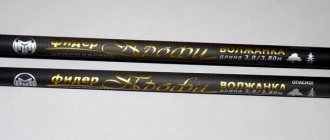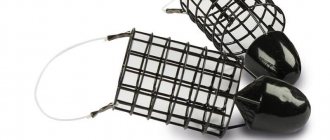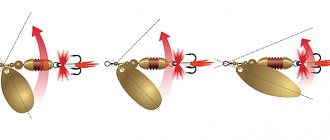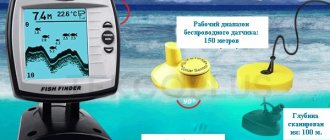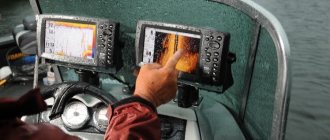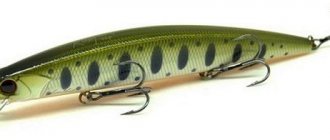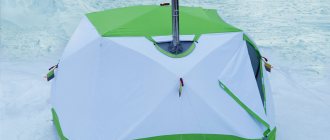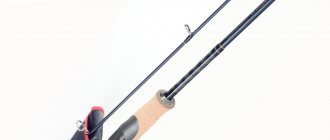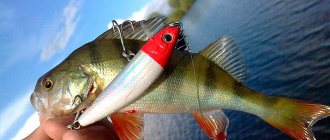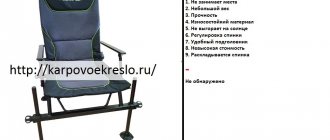Fishing with a feeder on the river has both advantages and disadvantages. The advantage of a feeder on a river is that the current washes out the bait from the feeders and carries it downstream, creating a feeding path for the fish. The fisherman’s task in river feeder fishing is to cast to the same place, creating a small feeding spot-path, and for this it is necessary that the feeder not be blown away.
If the current is very strong, use one or more of our recommendations. There are several basic rules for choosing feeders and gear for the current:
- The heavier the feeder, the less it will be carried away.
- The sinker of the feeder should be positioned so that it does not roll along the bottom.
- Use feeders with a plug, which will reduce the rate of feed leaching.
- Use spring feeders with lugs.
- Fish in shallower areas or at shorter distances.
- Look for areas with eddies and rip currents.
- Raise the rod onto the stand as high as possible.
- Use a smaller diameter line.
- Cast in the direction of the current.
- Change your fishing location.
Now let's look at these points in more detail.
Weight of the feeder during the current
The heavier the feeder, the more difficult it is to move it. Replacing it with a heavier model is the easiest way to keep it on the fast river. In weak currents at close distances and shallow depths, you can use feeders weighing up to 50 grams. If the depth is medium or large, and the casting distance is above 40 meters, you can use 60-80 gram feeders.
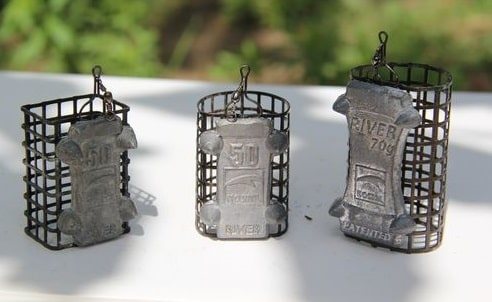
For very strong river currents with great depth, you can take models weighing under 100 grams. In general, select the weight of the sinker according to the location, starting with a light one. Just don’t forget to test your feeder rod; if you overload it, then force casting can lead to breakage of the blank.
Always try to use feeders of minimal weight, as the equipment with them is more sensitive.
Light feeders splash down much more quietly, which is very important in shallow areas of the reservoir.
Accessories for feeder on current
Among the incredible variety of installation schemes used in the English donkey technique, there are a number of techniques that work most effectively in fast currents. This list not only copes with the excellent motivation of fish to actively bite, but also promotes a simple long-casting technique and minimal possibilities of tangling equipment elements, which only contributes to the comfort of fishing in difficult conditions. You can install a feeder for fishing in the current using many classical methods that are well known even to a novice feeder, manipulating only the weight and shape of the feeder used.
Otherwise, the components of the twists are assembled from monofilament or wicker wood using fittings to connect the elements and allow them to be quickly changed, as well as to prevent tangling. The leash and hooks, as in classical equipment, affect the delicacy of the tackle and their parameters and characteristics depend on the bait used and the activity of the fish. The most popular methods used in fishing currents will be discussed in our future review.
Paternoster
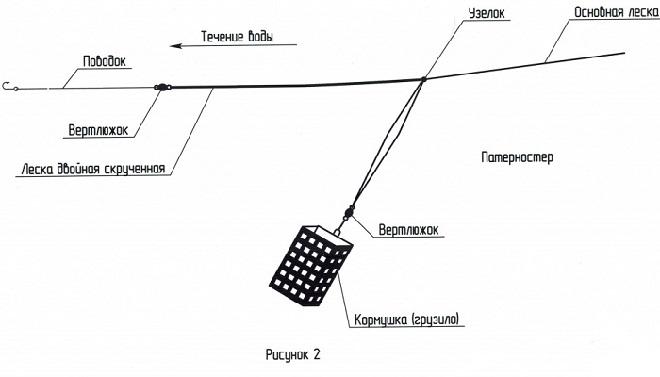
The most famous and simple way to equip a specific feeder is the classic paternoster. The loop is quickly mastered in its tying by a novice fisherman and is often prepared right on the shore of the reservoir, immediately before fishing. The paternoster is characterized by a low degree of tangling of the main cords, feeder trough and leash. In addition, this is a universal method of fishing both in standing small reservoirs and on rivers with strong currents. It is imperative for a feeder angler to master the tying of a paternoster loop, because the technique saves in different hunting conditions, which contributes to the mobility of feeder fishing, without losing on time-consuming re-equipment and labor-intensive installation technology.
As a rule, a nuance of catching currents in a paternoster is the use of elongated leads, since short elements 15–20 cm long are often the main cause of entanglements. Long lead lines, 50 cm and above, rarely confuse rigs, showing on the stream the effectiveness of fishing as a result of a kind of animation that occurs through the influence of water speed on inert plant, animal and artificial baits.
Asymmetrical and symmetrical loop
No less than the universal paternoster, it is popular for use on tandem currents from an asymmetrical and symmetrical loop. Having mastered the technique of tying these simple loops in design and operating principle, fishermen, depending on the strength of the currents and the accompanying inconvenient wind load factor, can finely regulate the degree of delicacy of the equipment. Thus, an asymmetrical loop is more sensitive than knitting with equal arms in the form of a symmetrical loop, but at the same time, its degree of tangling is an order of magnitude higher than a similar loop manipulation technique, and this is when using the same weight of the feeder.
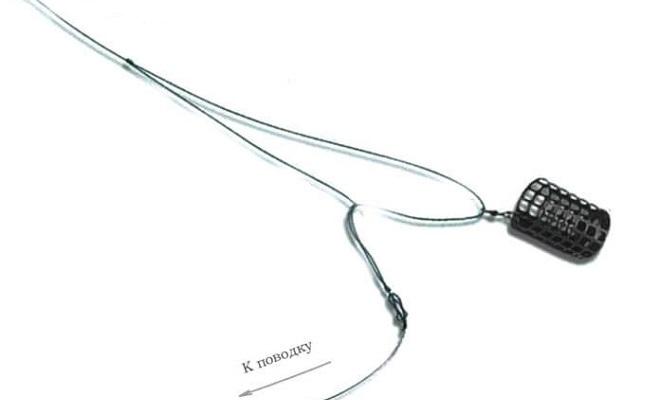
Despite all the disadvantages of loop ties, priority is given to their use when the fishing scenario involves catching cautious or insufficiently active fish. Beginner fishermen are recommended to master these techniques when fishing in still waters and, having worked out the casting technique well enough, move on to practice on the river, forming a tie in the classic style without any kind of modifications, only by equipping the loop with a feeder suitable for fishing currents.
Helicopter
Feeder rigging on the current based on the principle of the helicopter technique is used when fishing conditions require the use of short leashes with a length not exceeding 20 cm. Another advantage of the presented installation is considered to be the long-range inherent in the scheme, as is the original carp rig for catching fish from ultra-long distances. The helicopter installation has low tangleability due to its design features. Of course, considering the large number of additional elements, swivels and carabiners accompanying the assembly, the installation cannot be called delicate, but when it comes to catching active fish, even at high traction, the scheme works quite promisingly, fully meeting expectations.
Another negative factor is the use of small-sized baits in installations, and besides, the longer the leash used, the smaller the size of the bait should be, otherwise the fisherman will receive a guaranteed overlap, if not even when casting, then from the influence of the current and with quite a high probability percentage.
Equipment with anti-twist
Installations with the introduction of anti-twist devices into circuits receive mixed reviews. Some anglers consider this element a useful addition that completely eliminates overlaps and tangling. Another part of the feederists have a negative view of anti-twisters because of their massiveness, which makes the equipment rough and scares away fish, and classifies installations with the device as obvious training equipment when mastering the feeder for a beginner. But when it comes to fishing in strong currents, here the positions of anglers are similar and installation with a tubular anti-twist is quite capable of providing comfortable fishing in such conditions.
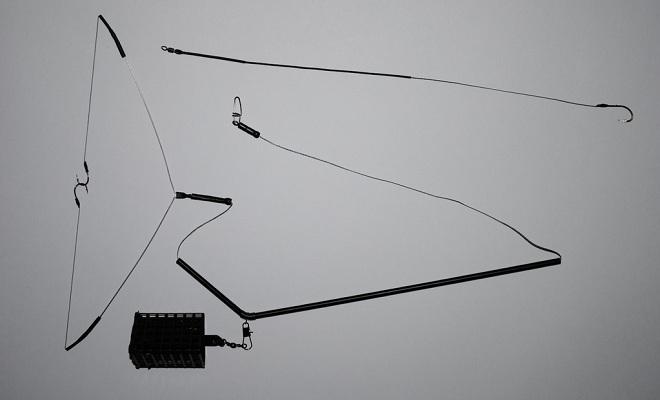
In addition, adding a counter-twist to the circuit provides options for using heavy feeders without fear of breaking the cord and, together with the choice of a reel with a low gear ratio, allows you to assemble a super-heavy feeder for catching powerful fish in strong currents. By sacrificing the delicacy of equipment by installing an anti-twist, anglers eliminate overlaps, gaining the opportunity for real trophy fishing, which other feeder installations in strong currents clearly cannot provide. The length of the leash in such matings does not play a key role, and therefore the feeder’s capabilities increase, only contributing to the quality of fishing and its final positive result.
The influence of the shape of the feeder on the flow
The shapes of feeders and springs are square, triangular, round, drop-shaped and others. The shape of the cage itself has virtually no effect on the stability of the feeder in the river current; the location of the sinker is much more important. We also note that the main water pressure falls on the fishing line, and not the feeder, so the streamlining of the shape is almost irrelevant.
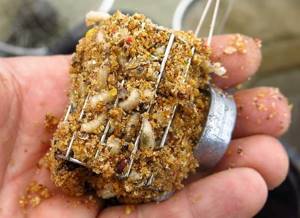
The weight should be located at the bottom of the feeder so that it does not roll along the bottom, for example, as in the photo above.
The most common ones on the current are metal cages and models with a round profile with a lower load.
Poorly suited for the flow of the feeder - bullets that have a displaced center of gravity, such models can roll along the bottom.

Such feeders fly very far, but due to the shifted center of gravity, they roll to the bottom.
Features of fishing with a feeder on the current
The feeder used in strong currents not only has a number of features in the assembly of equipment, but is also characterized by a unique fishing technique and installation. But before we begin to consider these factors affecting the comfort and efficiency of fishing, the angler should be aware of the reasons that force the use of changes and deviations from the classic feeder equipment.
Current equipment includes feeders with increased masses that help stabilize the installation on the bottom. But not only excessive weight affects the quality of fishing, the shape is also considered an important criterion. In shape, a well-chosen feeder, due to the large areas of contact with the soil, is not subject to drift by the current and clearly keeps the feeding point in working order, holding the fish in the right place. An important element of equipment is the main cord, namely its thickness. In currents, they try to use threads that are as small in diameter as possible, the result of which is considered to be a decrease in flow resistance.

Important! A strong current requires the installation of stiffer tips as alarms or quivertips, which facilitate the correct perception of real bites.
At the same time, the tip must withstand the high masses of the thrown feeders. Carbon fiber material fits these parameters well. The rods themselves are chosen from 3.5 to 4.5 meters in length, which indicates the long-range and reliability of the gear used in difficult fishing conditions. Speaking of reels, fishing practice shows the rationality of using middle-class spinning rods in feeder sets, ranging in size from 3000–4000 units and preferably with a baitrunner, which allows you to leave the tackle without control and supervision, even for a long period of time. The length of the leash depends on the type of fish caught and does not have specific recommendations for fishing currents; it is selected during the fishing session based on the activity of the trophy.
The use of feeder feeders with lugs
Lugs are protrusions on the sinker that cling to the bottom like an anchor. In some feeders the lugs are made like legs, and in some they are made like triangular waves, see photo.
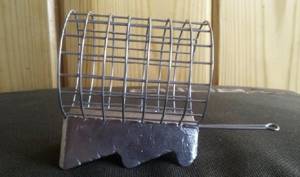
A 50 gram feeder with lugs can hold the bottom better than a 100 gram model without them, which is very important if you have thin braid and a medium-light feeder rod. You definitely need to have these feeders in your fishing arsenal.

Use a heavier feeder weight
This is the first of the most effective ways. Most often, it is by taking a heavier feeder that you can cope with the current. But there is one big and one small obstacle. The first is the feeder test, and the second is the lack of a suitable feeder in stock.
If you are planning to fish in a current, and even a fast one, then you need to purchase a heavy, or even extra heavy, feeder. The popular test of a rod up to 120 grams is not the limit; with this casting you can only cast 100 gram feeders (don’t forget that you need to add the weight of the bait to its weight and try not to exceed this value). For many rivers, feeder rods with a test weight of 140-160 grams or more may be suitable.
Although such a powerful class of feeders can be more likely attributed to carp rods than to feeders. Although the tip will still give the feeder its “trademark” sensitivity, the fast action of the blank will no longer be able to convey those sensations when playing fish, which is why so many people love fishing with a feeder.
It is clear that in the stock of any feeder there should be feeders for both standing water (30-60 grams) and for flow (80-120 grams or more). If the required weight is not available, and the feeder test allows it, then you can add a small weight to the weight of the feeder. But such a design “holds the bottom” worse than a monolithic feeder of the same weight.
Here you need to step back and say that the weight of the feeder should be “on the verge”, that is, you should not fish with a feeder that is too heavy, the weight of which will be too high for a given current. Why is it important? The feeder tackle will be optimally tuned when the feeder moves away when a fish bites . This causes the fish to self-hatch, and when fishing in the current with a properly selected feeder (with balanced equipment), the angler very often only has to remove the fish. If you fish with a heavy feeder, then the fish’s bite will not be able to tear it from its place, and its “correct” self-hooking will not work.
Using heavy feeders can cause them to shoot more often and even damage the clip on some reels. To throw such weight on thin lines and cords without fear, you can use a shock leader on the feeder. It’s better to adjust the casting distance using the rubber band on the spool.
Feeders with plugs
In order for the bait to be washed out of the feeders more slowly, you need to use more closed models, that is, with a smaller mesh cell, or with a plastic plug on the bottom side. This will allow most of the food to be delivered to the bottom, practically without losing it in the water column, and will also reduce the rate at which it is washed out.
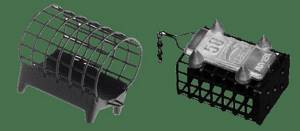
For initial feeding, it is better to use more open feeders with a large capacity, and carry out the fishing itself on the river with smaller and closed ones.
Types of feeder feeders
The most common are mesh feeders, which ensure precise supply of food and its rapid leaching, which ensures the active attraction of fish from all water horizons.
To make the mesh of such a cormak, metal or plastic is used.
Metal meshes are:
- round;
- triangular;
- rectangular;
- semicircular.
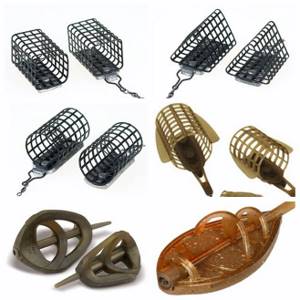
The advantages of a metal mesh are that when immersed, the wire “cuts” the water better and the feed sinks faster to the fishing point.
When you have to fish in the current, it is necessary that the feeder does not drift, or drifts minimally when immersed, and this effect can be achieved thanks to the design of the wire mesh.
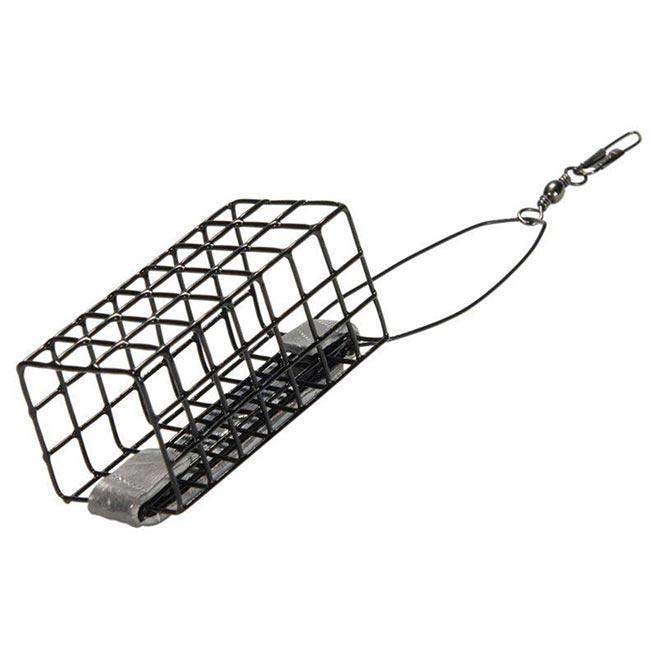
Plastic nets do not have this advantage and are used mainly when fishing in standing water. After sinking to the bottom, metal cormak are also carried away less, even if the current is quite strong, so they are considered river water.
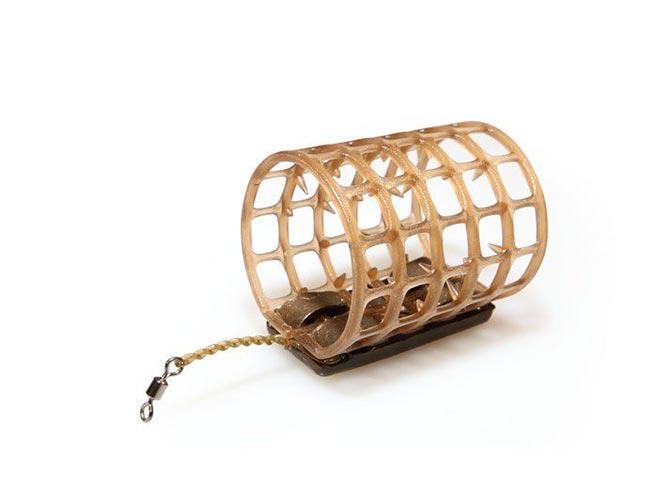
The choice of weight depends on the casting distance and the strength of the current; for river fishing, powerful heavy class feeders are used, which are convenient for casting the heaviest feeders.
The disadvantage of metal nets is that they do not float up well, and when reeling out the equipment they create a certain resistance, especially on the edges and in places with dense bottom vegetation.
Active feeder fishing involves frequent recasts, so the fisherman has to spend more effort when fishing using metal mesh.
With prolonged use, the paint on metal mesh will peel off and the wire will corrode, which is also a disadvantage. Plastic meshes do not rust and are mostly round in shape, although now there are also square and rectangular plastic meshes in stores.
Rectangular-shaped products are better fixed at the bottom of the reservoir, and they are less likely to be carried away by the current, if there is one.
Advantages of plastic mesh
